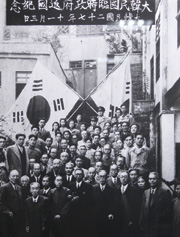Japanese Occupation and Korea's Independence Movement

High-ranking officials from Korea's Provisional Government in Shanghai pose for a commemorative photo in 1945.
In the 19th century, Korea remained a "Hermit Kingdom," adamantly opposed to Western demands for diplomatic and trade relations. Over time, a few Asian and European countries with imperialistic ambitions competed with each other for influence over the Korean Peninsula. Japan, after winning wars against China and Russia, forcibly annexed Korea and instituted colonial rule in 1910.
Colonial rule stimulated the patriotism of Koreans. Korean intellectuals were infuriated by Japan's official assimilation policy, which even banned Korean-language education in Korean schools. On March 1, 1919, a peaceful demonstration calling for independence spread nationwide. The Japanese authorities ruthlessly repressed the demonstrators and their supporters, slaughtering thousands.
Although it failed, the March 1 Independence Movement created strong bonds of national identity and patriotism among Koreans. The movement led to the establishment of a Provisional Government in Shanghai, China, as well as an organized armed struggle against the Japanese colonists in Manchuria. The Independence Movement is still commemorated among Koreans every March 1, which is designated a national holiday.
During the colonial period, Japan's economic exploitation of Korea continued. The lives of Koreans deteriorated under colonial rule until the end of World War II in 1945.